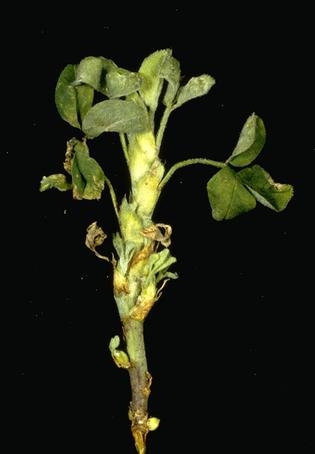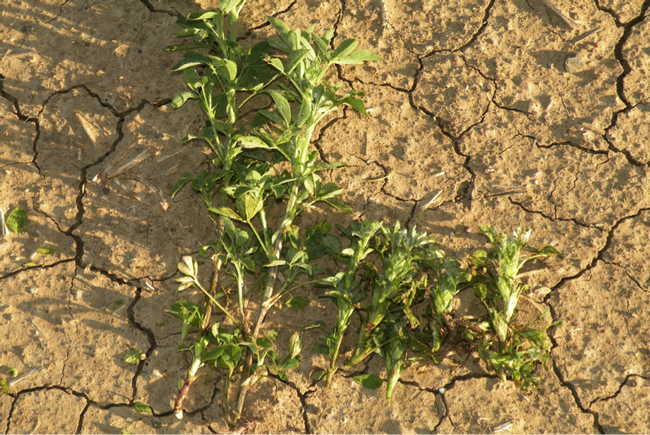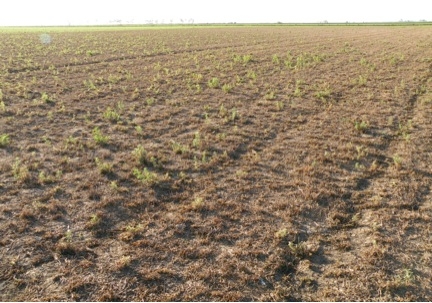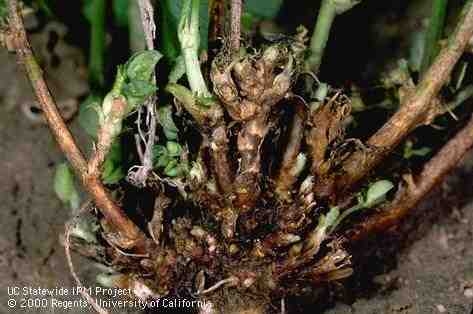This is the time of year that alfalfa fields provide a lush green carpet, outgrowing the damage from 4 months of cold and frost in California’s Central Valley. But not all fields are emerald green-some show the ugly, patchy, stunted evidence of a nasty little invader: stem nematode.
Of course you can’t see the nematodes (ugly or not) with the naked eye but they sure make the alfalfa look ugly.
Stem nematodes (Ditylenchus dipsaci) are causing significant damage to alfalfa fields again this year in the Sacramento and San Joaquin Valleys. These microscopic worm-like pests primarily move through fields in water and infect the above ground portion of the plants (crowns and stems). Feeding damage includes stunted plants with swollen stems that just sit there, hardly growing (Figure 2). Additional symptoms include ‘white flagging’ where individual stems of infected plants appear in the field, standing out like sore thumbs. Eventually, stand loss occurs when the nematodes injure the crowns, resulting in secondary pathogens moving in and causing crown rot.
Unfortunately, this is not the only pest this time of year. For nematode-infected stands, watch carefully for alfalfa weevils, as plants that are not growing will be much more sensitive to weevil damage. Thresholds for weevils are 20 larvae per sweep, but in situations where the alfalfa is not growing, that number will be far less, since the crop is less able to out-grow the feeding. The threshold will depend on the severity of the nematode damage and weevil pressure. As a result, it is important to monitor fields and treat when there are significant signs of feeding damage on the leaves.
Stem nematode favors temperatures in the 60-70oF range, so generally only impacts the first hay cutting. When temperatures warm in the late spring, nematodes go dormant in the soil, as we seldom pick it up in plant tissue. When temperatures cool in the fall, the nematodes re-infect plants.
But, what to do? Since there are no registered or cost-effective sprays, a grower’s main strategy is to plant resistant varieties, and prevention-keep that pest out if at all possible! And keep it from spreading if it already occurs in some fields.
Management Recommendations
Equipment sanitation: Infected hay harvesting equipment will carry nematodes in plant and soil residue, so avoid moving contaminated farm machinery from stem nematode infested to clean fields. Harvest nematode-free fields before infested fields. Clean equipment when moving from a stem nematode infested field to a clean field. This can be done using a high-pressure washer or blower, or by cutting grass hay prior to moving back into alfalfa.
Crop rotation: Alfalfa is the primary host for alfalfa stem nematode so rotation with non-host crops such as tomatoes, sunflowers, and wheat on a 2- to 4-year basis will reduce alfalfa stem nematode populations (longer rotations are better). Overseeding with grasses is not a rotation, since even a few alfalfa plants will continue to host the nematodes in the field.
Water management: Although this is hard to prevent in some cases, if water is moving off of infected fields, growers should attempt to prevent this water from moving to non-infected fields, or reduce runoff. High numbers of stem nematode have been found in irrigation and storm water runoff from infected fields. Where water is reused on fields, this may be a major source of infection for healthy fields.
Livestock: Uncomposted manure from animals fed stem nematode infested hay may be a source of this pest. Likewise, animals such as sheep grazing in the alfalfa for winter weed control can move the stem nematode around fields via tracking dirt on their hooves or in manure.
Pesticides: Unfortunately, no nematicides are currently registered for use against the alfalfa stem nematode in established alfalfa fields that control the nematode sufficiently to enhanced yields.
Resistant varieties: If stem nematode is prevalent in an area, growers should plant highly resistant (HR) varieties. The use of resistant varieties, on which nematodes are not able to reproduce, is a well-known management technique. However, resistance is not immunity, and even the best highly resistant varieties may become overwhelmed by the pest during years with extended periods of wet, cool conditions. Plant breeders are currently working on developing varieties with even higher levels of resistance (showing at least 70% stem nematode resistance). The mechanism for the resistance is not well understood, but may be biochemical, whereby the nematodes are chemically prevented from reproducing in the plant. Enhanced levels of resistance should be available in about 3-4 years.
Certified seed: Growers should always plant certified seed to minimize risks of introducing alfalfa stem nematode as well as other pests, weeds, and diseases in their fields. Certification guarantees knowing the characteristics of the variety planted as well as seed quality.
Additional Reading
Long RF, B Westerdahl, and DH Putnam. 2010. Stem nematode management in alfalfa hay production. In: Proceedings, 2010 Western Alfalfa & Forage Conference, http://alfalfa.ucdavis.edu/+symposium/2010/ (proceedings and powerpoint).
Westerdahl BB and C Frate. 2007. Parasitic nematodes in alfalfa. In: Irrigated Alfalfa Management for Mediterranean and Desert Zones [Eds.] Summers and Putnam. UC ANR 3512. http://alfalfa.ucdavis.edu/IrrigatedAlfalfa/pdfs/UCAlfalfa8297Nematodes_free.pdf
